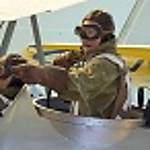Tom,
I don't think they intended to remain a "landlocked" power. I've got an online book titled "Fascist Flattops" that discusses the ambitions of Germany and Italy concerning carriers. Five reached some level of construction. Below is part of the intro from the book:
Somewhere 55 kilometres off the coast of Poland, beneath the dark, cold waters of the Baltic Sea, lies the colossal ghost of a haughty dream of world dominance. While fish sluggishly fin in and out of her silent spaces, silt settles like the dust of history over her rusting shoulders. It has been nearly seventy years since she last saw the light of day. And what an awful day that was.
She is Flugzeugträger (Aircraft Carrier) Graf Zeppelin, one of five aircraft carriers commenced by the navies of the two European fascist powers of the Second World War—Germany and Italy. Of the five attempted carriers, Graf Zeppelin came the closest to being operational. In the end, her only military accomplishment was a benefit to the Allies—keeping 30,000 tons of much needed steel from the U-boat builders of the Third Reich.
The concept of the aircraft carrier, while not new when the war began in 1939, could certainly be said to be untested. Carriers were a military weapon system about to prove their place at the top of the food chain, but for the undecided and the late-to-the-game navies of Italy and Germany, there was still plenty of heated debate and animosity within these services and without. The great carrier powers of the Second World War were three—the United States Navy, the Imperial Japanese Navy and the Royal Navy. They all had been in the game for a long time and had built relatively deep experience with technologies for deploying and operating carriers throughout their empires. In fact, it was the defence and extension of these very empires, stretched across massive expanses of open ocean from Scapa Flow to the Falklands, from San Diego to the Philippines and from Sakhalin to Sarawak, which gave impetus to the development of carriers and their supporting task forces. Carriers would be involved in the opening salvos of both the Pacific and the European wars—with HMS Courageous being torpedoed just a couple of weeks after the declaration of war, and Japanese carriers delivering a crippling but not fatal blow to the Americans at Pearl Harbor. Carriers would be in the thick of things in the closing weeks of the war in the Pacific, and by then had supplanted the heavy battleship as the most important weapon in any navy’s arsenal.
As mentioned, Germany came into the aircraft carrier game later than other countries with designs on the world. This was largely because her militaries (Kriegsmarine and Luftwaffe) were prevented from doing so by the Treaty of Versailles—at least on paper. Of course, when the Nazis took control of the government, they largely thumbed their noses at the treaty that Germany had been forced to sign in 1919. Re-armament or “Aufrüstung” was conducted both under the noses of and in the face of the Allies.
In the summer of 1935, a new Anglo-German Naval Treaty gave Germany permission to construct new capital ships including aircraft carriers up to 38,500 tons displacement. It didn’t take long before Adolf Hitler announced plans to construct the first of four planned carriers – for the Kriegsmarine had been developing plans since 1934. In secret, a delegation of Kriegsmarine and Luftwaffe officers visited Japan to obtain technology. There, they visited the recently completed IJN Akagi, one of the Japanese carriers that would launch aircraft in the attack on Pearl Harbor six years later. Along with the German lack of experience in the carrier business, came an even greater shortfall in appropriate aircraft for carrier operations. Both the Germans and the Italians chose to select aircraft from their air forces and modify them for carrier duty – a process that would prove, for the most part, unsatisfactory.
By 1937, plans had been largely completed, enough at least to lay down the keel on Slipway One at Kiel’s Deutsche Werke for an 861-foot-long fleet carrier called Flugzeugträger “A”. Work proceeded at full bore until the end of 1938 when, on 8 December, she was christened KMS Graf Zeppelin by Countess Hella von Brandenstein-Zeppelin, the daughter of the ship’s namesake—Count Ferdinand Zeppelin. Graf Zeppelin was then cut loose to slide down the slipway and into a launch basin at Deutsche Werke, Kiel. She was then attended by numerous tugs who shepherded her to a berth on a dock where she would be fitted up and readied for her shakedown cruise. Weeks after her launch, another carrier, known simply as Flugzeugträger “B”, was laid down and work commenced. The ship would be the second of the Graf Zeppelin class of carriers, and it is widely believed that at her christening she would carry the name KMS Peter Strasser, named after the First World War commander of Germany’s airships.
In September of 1939, Graf Zeppelin was, by all accounts, 85% complete when war broke out. With focus on other military events taking place, on the building of U-boats and the finishing of other capital ships, progress slowed until, in July of 1940, work was ordered stopped. Her life from this point forward would be a series of movements east and west across the Baltic coast of Germany and Poland—attempts to keep her out of bombing range mixed with rejuvenated periods of work to complete her. She would languish at wharfs and backwater anchorages from Gotenhafen to Kiel to Stettin until 1945, when the imminent threat of the advancing Soviet Red Army pushed her skeleton crew to scuttle her in shallow water, a rusting mountain of 30,000 tons of steel sitting on her keel at a bend in the brackish Parnitz River.
Like almost all capital ships of the Kriegsmarine in the Second World War, her career, had she become operational, would have been short and not worth the effort. In the war, German battleships and heavy cruisers were either hounded to death by the Royal Navy surface fleet or forced to hide deep in Norwegian fjords with little to show for the millions upon millions of reichsmarks spent on their construction. Graf Spee was scuttled in the estuary of the River Platte. Bismarck was sunk in the North Atlantic, Tirpitz spent the war hiding. Gniesenau was scuttled. Prinz Eugen was a gunnery platform used in support of ground troops, and in the end, was towed to Bikini Atoll in the Pacific where she survived two nuclear bomb tests. When the most celebrated engagement of Kriegsmarine surface ships was the “Channel Dash”, the escape from Brest to Brunsbüttel Locks at the mouth of the Kiel Canal via the English Channel, you know your plans for naval domination are hopeless. The fate of Graf Zeppelin would have been no different. And the Germans knew it.
Despite a later attempt to complete Graf Zeppelin, she would end her war service a rusting hulk which not only kept 30,000 tons of steel from Admiral Dönitz’s submarine building program, but which eventually fell into the hands of the Red Army. The two other attempts to build a carrier for the Kriegsmarine also failed, though less spectacularly. Flugzeugträger “B” (Peter Strasser) was scrapped where it sat on the slipway, less than 50% complete. Another attempt, a conversion of the brand new heavy cruiser KMS Seydlitz to a carrier, also failed. She had her superstructure removed at great cost and her guns deployed to the Atlantic Wall, and that being done, spent the rest of the war as did Graf Zeppelin—a white elephant and somewhat of an embarrassment.
I'm glad to see this kit being produced. I can't afford something like this and even if I could I have no place to display it. But the ship is a part of history and in my mind deserves to be represented.
Just my $0.02
Thanks
John





























